Calauag
Calauag, officially the Municipality of Calauag (Tagalog: Bayan ng Calauag), is a First (1st class) municipality in the province of Quezon, Philippines. According to the 2015 census, it has a population of 73,139 people.[4]
Calauag Kalawag (Old Tagalog) | |
|---|---|
| Municipality of Calauag | |
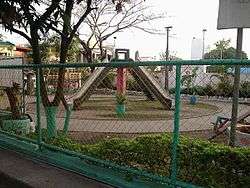 Calauag Central Park | |
 Seal | |
| Etymology: Tortoise | |
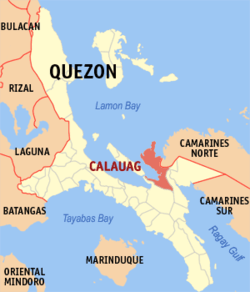 Map of Quezon with Calauag highlighted | |
OpenStreetMap 
| |
.svg.png) Calauag Location within the Philippines | |
| Coordinates: 13°57′27″N 122°17′15″E | |
| Country | Philippines |
| Region | Calabarzon (Region IV-A) |
| Province | Quezon |
| District | 4th District |
| Foundation | June 13, 1851[1] |
| Barangays | 81 (see Barangays) |
| Government | |
| • Type | Sangguniang Bayan |
| • Mayor | Rosalina O. Visorde (NPC) |
| • Vice Mayor | Leah M. Dela Cruz (NPC) |
| • Representative | Angelita "Helen" D.L. Tan (NPC) |
| • Provincial board members | |
| • Electorate | 43,715 voters (2019) |
| Area | |
| • Total | 324.71 km2 (125.37 sq mi) |
| Population (2015 census)[4] | |
| • Total | |
| • Rank | |
| • Households | 16,451 |
| excluding 9 Barangays from East Quezon, currently occupied by Santa Elena | |
| Demonym(s) | Calauagenian Calauageño/-a (Filipino) |
| Economy | |
| • Income class | 1st municipal income class |
| • Poverty incidence | 24.45% (2015)[5] |
| • Revenue (₱) | 157,781,413.38 (2016) |
| Time zone | UTC+8 (PST) |
| ZIP code | 4318 |
| PSGC | |
| IDD : area code | +63 (0)42 |
| Climate type | tropical rainforest climate |
| Native languages | Manide Tagalog |
| Sister localities | Guinayangan Tagkawayan Buenavista |
| Numbered highways | |
| Major religions | Roman Catholic, Protestantism |
| Feast date | June 29 |
| Catholic diocese | Diocese of Gumaca |
| Patron saint | Peter the Apostle Virgin of Fatima |
| Website | www |
It is about 232 kilometres (144 mi) southeast of Manila and 95 kilometres (59 mi) east from Lucena, the capital of Quezon.
Geography
Calauag is located on the north-eastern end of Tayabas Isthmus. The Daang Maharlika or Pan-Philippine Highway runs at the town after Lopez in Southbound and after Santa Elena at the Northbound or from Manila. At the north end of Quirino Highway, it meets Daang Maharlika in Barangay Tabugon. It also meets the north end of Guinayangan Provincial Road which also meets Daang Maharlika in Barangay Sumulong. It is bounded to the north-west by Calauag Bay, south-west by Lopez, to the east by Guinayangan, and to the north by Basiad Bay and Tinig Bay; it is separated from Alabat Island by a 1 kilometer narrow strait.
Barangays
Calauag is subdivided into 81 Barangays and 9 disputed barangays:
- Agoho
- Anahawan
- Anas
- Apad Lutao
- Apad Quezon
- Apad Taisan
- Atulayan
- Baclaran (Poblacion)
- Bagong Silang
- Balibago
- Bangkuruhan
- Bantolinao
- Barangay Uno (Poblacion)
- Barangay Dos (Poblacion)
- Barangay Tres (Poblacion)
- Barangay Cuatro (Poblacion)
- Barangay Cinco (Poblacion)
- Bigaan
- Santa Brigida [Binutas]
- Biyan
- Bukal
- Buli
- Dapdap
- Dominlog
- Doña Aurora
- Guinosayan
- Ipil
- Kalibo [Santa Cruz]
- Kapaluhan
- Katangtang
- Kigtan
- Kinamaligan
- Kinalin Ibaba
- Kinalin Ilaya
- Kumaludkud
- Kunalum
- Kuyaoyao
- Lagay
- Lainglaingan
- Lungib
- Mabini
- Madlangdungan
- Maglipad [Rosario]
- Maligaya
- Mambaling
- Manhulugin
- Marilag [Punaya]
- Mulay
- Pandanan
- Pansol
- Patihan
- Pinagbayanan (Poblacion)
- Pinagkamaligan (Poblacion)
- Pinagsakayan
- Pinagtalleran (Poblacion)
- Rizal Ibaba
- Rizal Ilaya
- Sabang Uno (Poblacion)
- Sabang Dos (Poblacion)
- Salvacion
- San Quintin
- San Roque Ibaba
- San Roque Ilaya
- Santa Cecilia
- Santa Maria (Poblacion)
- Santa Milagrosa
- Santa Rosa
- Santo Angel [Pangahoy]
- Santo Domingo
- Sinag
- Sumilang
- Sumulong
- Tabansak
- Talingting
- Tamis
- Tikiwan
- Tiniguiban
- Villa Magsino
- Villa San Isidro
- Viñas
- Yaganak
- Don Tomas
- Guitol
- Kabuluan
- Kagtalaba
- Maulawin
- Plaridel
- Patag Ibaba
- Patag Ilaya
- Tabugon
Town proper
The town center (poblacion) consists of 12 barangays and 11 blocks from the PNR Station in the East to Pinagkamaligan ES on the west. Going west from Barangay Pinagtalleran via Quezon Street, there are five blocks of high concentration of shops, groceries, and banks.
The Government Center is located in the South of the town which consists of Municipal Hall which houses the City Library, Fire Station, Police Station and Precinct, and the Municipal Council building. Quezon Plaza is a well-used spot for programs and events. The Livelihood Center is two blocks away from the Plaza and Quezon Street. Central Park is also located in front of the Plaza and the City Hall.
Climate
Calauag has a Tropical Climate like most of the country. Summers are hot and dry while the rainy season is cold and wet . It also falls under the Type IV Tropical Climate which has Rainfall is more or less evenly distributed throughout the year. Rainy season must be expected from end of May to last week of December
History
According to the writings of Valentin Martin in his "Ensayo de una sintesis de los trabajos realizados sos las corporaciones religiosas Españolas de Filipinas", the first record of the establishment of a settlement in Calauag dates as far as the year 1584. However, the formal founding of the town was placed in the year 1851 with the union of the settlements in Apad and Calauag.[6]
The first elected Captain of the town was Juan Sunog. In 1897 the town was placed the Revolutionary Government and Alipio Declaro became the Municipal President. In 1914 under Municipal President Marciano Roldan, the town was destroyed by fire for the first time in its history. On December 24, 1941, the town was occupied by the Japanese Imperial Army and on January 14, 1942, the town was again destroyed by fire. On April 19, 1945, the United States and Filipino forces liberated the town from Japanese occupation. The general headquarters of the Philippine Army and Constabulary under the Commonwealth regime was built and station in Calauag during and after the war from 1945 to 1946 against the Japanese.
Disputed barangays
Calauag experienced a big controversy due to a decade long boundary dispute with the town of Santa Elena in the Province of Camarines Norte which resulted in a Supreme Court case, Presidential intervention, and the loss of a quarter of its land area. The disputed barangays were Cabuluan, Don Tomas Morato, Guitol, Kagtalaba, Maulawin, Patag Ibaba, Patag Ilaya, Plaridel, and Tabugon.
On October 14, 1991, the Provincial Government and Municipal Government of Calauag ordered the demolition of a boundary marker installed by the DENR. In October 1995, then-President Fidel V. Ramos came to Calauag to meet with local officials to resolve the boundary dispute between the two provinces and surveyed the whole disputed area. Calauag retained its jurisdiction, however, the case was elevated to the Supreme Court. The Case of Province of Quezon vs. Province of Camarines Norte eventually ruled in favor of Camarines Norte and Calauag ceased its political jurisdiction on the said barangays.[7]
Demographics
|
| ||||||||||||||||||||||||||||||||||||||||||||||||
| Source: Philippine Statistics Authority[4][8][9][10] | |||||||||||||||||||||||||||||||||||||||||||||||||
Economy
Calauag has an agricultural-based economy. Most economic activity happens in Municipal Market and its vicinity. Most agricultural products are coconut-based and followed by rice, corn, fish, crabs and other seafoods. It is currently classified as First class-municipality.
Local government
The mayor for the 2019–2022 term is Rosalina O. Visorde, wife of former Mayor Luisito S. Visorde. Leah Dela Cruz is the town's incoming vice mayor. Under the 1987 Constitution, The mayor is restricted to three consecutive terms with three years per term, although a mayor can be elected again after an interruption of one term. The mayor has the direct control of the departments while the Municipal Administrator is indirectly in charge of all departments of the Government while the Vice Mayor is in charge of the Municipal Council which consists of seven Councilors and one Municipal Sangguniang Kabataan/SK (Youth Council) Chairman and a President of Liga ng mga Barangay which are elected every three years and Municipal Administrator is appointed by the mayor.
Congressional and provincial legislators
In the 18th Congress of the House of Representatives, Calauag is Represented by Helen Tan of the Fourth Congressional District of Quezon province. Representative Tan is now term-limited. The disputed barangays meanwhile are under First Congressional District of Camarines Norte, Represented by Josefina "Josie" B. Tallado. However, the disputed barangays still receive funds from some of the board members of Quezon province.
In the Provincial Board, the 4th District of Quezon is represented by four incoming board members for the 2019–2022 term: Roderick "Derick" Magbuhos (NPC), Rhodora "Dhoray" Tan (NP) and Isaias Ubana II (NPC).
Past Local Chief Executive[11]
| Term | Chief Executive | Others: (Political Party, position and origin) |
|---|---|---|
| Spanish Era | ||
| 1851 | Juan "Juan Sunog" Parcero | Atimonan |
| 1851 | Pascual Siazon | Apad |
| 1852 | Benito Jorbina | Calauag |
| 1853 | Antonio Cerilla | Apad |
| 1854 | Eustaquio Geneblazo | Atimonan |
| 1855 | Pantaleon Cerdinia | Apad |
| 1856 | Pedro Juaris | Nueva Cáceres |
| 1857 | Vicente Penidles | Apad |
| 1858 | Marciano Junillis | Nueva Cáceres |
| 1859 | Agapito Jorbina | Calauag |
| 1860 | Arcadio Cerilla | Apad |
| 1861 | Felipe Labiste | Libmanan |
| 1862 | Benito Jorbina | 2nd Term, Apad |
| 1863–1864 | Pantaleon Jorbina | Apad |
| 1865–1866 | Domingo Jorbina | Calauag |
| 1867 | Antonio Uransa | Gumaca |
| 1868 | Lucas Dela Costa | Mauban |
| 1869–1870 | Domingo Jovida | Calauag |
| 1871–1872 | Raymundo Locido | First Term, Apad |
| 1873–1874 | Antonio Lerum | Apad |
| 1875–1876 | Raymundo Locido | 2nd Term, Apad |
| 1877–1878 | Canuto Escolano | Apad |
| 1879–1880 | Juan Geneblazo | Calauag |
| 1881–1882 | Severino Villafranca | |
| 1883–1886 | Juan Enteria | Gumaca |
| 1887–1888 | Sinfroso Matos | Gumaca |
| 1889 | Raymundo Daroga | Gumaca |
| 1890–1891 | Pedro Segui | Gumaca |
| 1892–1893 | Sebastián Uransa | Gumaca, Maura Law passed on 1893 |
| 1894 | Antonio Lerum | 2nd Term, Apad |
| 1895–1896 | Tomás Rañola | Last Capitán Municipal, Lucban |
| Philippine Revolution | ||
| 1897–1899 | Alipio Declaro | First Municipal President. Mauban |
| 1900 | Juan Lerum | Calauag |
| 1901–1903 | Hilario Cantre | Cantre Street named after him in Barangay Poblacion Tres. Gumaca |
| 1904–1905 | Felix Jubilo | Calauag |
| 1906–1907 | León Tañada | Tañada Street named after him in Barangay Poblacion Dos. Gumaca |
| American Civil Government | ||
| 1908–1909 | Basilio De Guzman | De Guzman Street in Barangay Poblacion Dos named after him. Gumaca |
| 1910–1912 | Arcadio Vera Cruz | Vera Cruz Street in Barangay Poblacion Uno named after him. Atimonan |
| 1913–1916 | Marciano Roldan | Roldan Street in Barangay Poblacion Tres named after him. Boac |
| 1916–1922 | Pedro Pica | Atimonan |
| 1922–1925 | Espiridion Argüelles | Arguelles Street in Barangay Poblacion Uno named after him. Calauag |
| 1925–1928 | Armando C. Villaverde | Calauag |
| 1928–1931 | Donato O. Cabangon | Calauag |
| 1931–1934 | Jacinto Lerum | Calauag |
| Commonwealth | ||
| 1934–1938 | Tomás Bernabéu Morató | Last Municipal President of Calauag, First Mayor of Quezon City. Morato Street in Town Proper named after him. NP Calauag |
| 1938–1940 | José Jiménez | First Municipal Mayor. Calauag |
| Japanese-sponsored Philippines | ||
| 1941–1947 | Sisenando V. Villarubia | Japanese Occupation Mayor of Calauag. Town proper raged with fire during his reign due to war. Villarubia Street in Town Proper named after him. Atimonan |
| Third Republic | ||
| 1948–1951 | Arturo Morató | Also became Mayor of Tagkawayan. Calauag |
| January–April 1952 | Cirilo Pareja | Atimonan |
| April 1952 – 1955 | Simon Leonor | Calauag |
| January 1956 – December 1959 | Edgardo S. Cabangon | First Term. Cabangon Street in Barangay Poblacion Cuatro named after him. Calauag |
| January 1960 – December 1964 | Marceliano C. Parcero | Calauag |
| Bagong Lipunan era | ||
| January 1965 – February 3, 1982 | Edgardo S. Cabangon | Second Term. Mayor during Marcos dictatorship. LP, Assassinated |
| February 4, 1982 – February 15, 1986 | Julio U. Lim, M.D. | Removed from Office due to EDSA People Power Revolution. LP. Calauag |
| People Power Revolution, Restoration of Democratic Government | ||
| February 16, 1986 – December 1987 | Rogelio Regala | Officer in charge. Calauag became first-class municipality. Calauag |
| enactment of 1987 Constitution | ||
| February 2, 1988 – December 30, 1995 | Julio U. Lim, M.D. | East Quezon occupied by Camarines Norte. Camarines Norte v. Province of Quezon ruled that East Quezon belongs to Santa Elena. Second Term. |
| June 30, 1995 – June 30, 2004 | Pedro C. Inofre | Calauag |
| June 30, 2004 – June 30, 2010 | Eric N. Entienza | Calauag recovered its status as first-class municipality. Lakas-CMD Calauag |
| June 30, 2010–June 30, 2019 | Luisito S. Visorde | Incumbent. LP/NUP/NPC Calauag |
| July 1, 2019–June 30, 2022 | Rosalina Visorde | NPC, Sariaya, Incumbent |
Notable points of interest
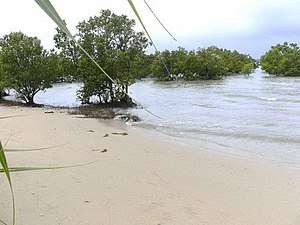
- Capaluhan Beach
- Pulong Pasig
- Pangahoy Beach
- Santa Milagrosa Cave
- Calauag Central Park
- Calauag Crossing
- Quezon Plaza
- Yaganak Hanging Bridge
- The "C" Lighthouse
- Quezon Canal
- Calauag Municipal Library
- Pinagtalleran Playground
- Calauag East Central Elementary School
- Morato Family Ancestral House
Infrastructure
Transportation
Calauag is accessible by Land Transportation like bus, and train via PNR Hondagua of Bicol Express Service. Calauag Station is currently under renovation due to damages of Typhoons and Storms and the Intercity Service is currently defunct. Traveling around the town proper is no problem since there are thousands of tricycles circling the Town Proper.
Utilities
Quezon I Electric Cooperative (QUEZELCO 1)[12] provides Electricity to the entire 3rd and 4th congressional districts including Santa Elena, Camarines Norte and Del Gallego, Camarines Sur. Trans-Asia Renewable Energy will be constructed the 10 MW wind energy project soon to cope with the KW demand of the whole town and feed into the grid. Calauag Water District (CWD) provides water to the residents of the Town Proper and nearby barangays (villages). The Yaganak-Mambaling Dam is the source of water for the entire town. The Local, NDD and DSL internet are provided by PLDT which absorbed the local franchise of Santos Telephone Corporation which recently went into bankruptcy. The wireless network and internet are provided by national telecommunications companies PLDT (Smart and Sun Cellular) and Globe. Digital Cable Television is provided by local cable operator (Calauag CATV System) and national satellite television providers (Cignal, G Sat, and SkyDirect). While liquified petroleum gas may be purchased per cylinder tanks in gasoline stations or in local distributors.
Education
Public Schools
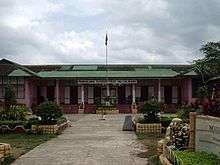
Public Schools are operated by the Department of Education-Quezon and divided by two districts: The East District and The West District. There are also one public high school that operates inside the town proper.
- Sabang Elementary School (K-6) on Quezon Street Ext.
- Pinagkamaligan Elementary School (K-6) on Rizal Street Ext.
- Calauag East Central Elementary School (K-6) on Declaro Street, between Bonifacio Street and Rizal Street
- Municipal Sector Elementary School (K-6) on Rizal Street beside the East Central Elementary School
- Santa Maria Elementary School (K-6) on Rizal Street
- Calauag National High School (7-12/Junior High School-Senior High School) on Maharlika Highway
Private Schools
- Calauag Central College (K-12+College level) on Rizal Street corner Arguelles Street
- Calauag Montessori
- Saint Peter's School (Catholic, Parochial School) (Junior High School-Senior High School) on Rizal Street beside the Saint Peter Parish
- Froebelian School of Calauag, Inc. (Pre-elem – G6) on Barangay Cinco
Media
Calauag and nearby towns were being served by Radyo Natin 100.9 FM and QuezoNews-FM 94.5
Notable natives/residents
- Tomas Morato – last Municipal President (Jan. 1935-Dec. 1937) first Municipal Mayor of Calauag (Jan 1938 – Dec 1940) . First Representative of the 2nd District of Tayabas
- Manoling Morato – PCSO Chairman and former TV host
- Arturo Morato Sr.- first licensed pilot (1936) and first Mayor of Tagkawayan, Quezon.
- Rey Danseco – International Boxing Judge, journalist, TV Host, Radio Commentator
- Edelyn Cornejo – former Star Circle Kid Questor, child actress
- Maria Regine Maravilla Talento – Star Circle Kid Questor, child actress
- Romeo Asinas – stuntman & fight scene instructor
- Raymundo Punongbayan – former director, Philippine Institute of Volcanology and Seismology
- Madeleine Nicolas – stage and film actress
- Gerry Igos – 1989 Philippine cycling champion
- Ice Seguerra – former host Eat Bulaga! and singer
Sister cities
Historically, the sister cities of Calauag are Guinayangan (Settlement started at Guinayangan before moving to Viñas and Apad), Tagkawayan (Daughter town of Guinayangan), and Buenavista (then Piris).
Gallery
- Saint Peter the Apostle Parish Church
 Kapaluhan beach in Calauag
Kapaluhan beach in Calauag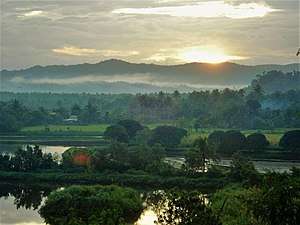 Calauag countryside
Calauag countryside
References
- https://m.facebook.com/story.php?story_fbid=1003152659852729&id=100004740124711
- "Municipality". Quezon City, Philippines: Department of the Interior and Local Government. Retrieved May 31, 2013.
- "Province: Quezon". PSGC Interactive. Quezon City, Philippines: Philippine Statistics Authority. Retrieved November 12, 2016.
- Census of Population (2015). "Region IV-A (Calabarzon)". Total Population by Province, City, Municipality and Barangay. PSA. Retrieved June 20, 2016.
- "PSA releases the 2015 Municipal and City Level Poverty Estimates". Quezon City, Philippines. Retrieved January 1, 2020.
- "Municipality of Calauag". Quezon Province. Archived from the original on October 14, 2012. Retrieved October 12, 2012.
- "Province of Camarines Norte Vs. Province of Quezon, Re: Urgent Petition to Cite Governor Eduardo T. Rodriguez of Quezon Province, and Mayor Julio U. Lim of Calauag Quezon, in contempt of court". G.R. No. 80796. Supreme Court of the Philippines. October 11, 2001. Archived from the original on October 12, 2016. Retrieved November 26, 2013.
- Census of Population and Housing (2010). "Region IV-A (Calabarzon)". Total Population by Province, City, Municipality and Barangay. NSO. Retrieved June 29, 2016.
- Censuses of Population (1903–2007). "Region IV-A (Calabarzon)". Table 1. Population Enumerated in Various Censuses by Province/Highly Urbanized City: 1903 to 2007. NSO.
- "Province of Quezon". Municipality Population Data. Local Water Utilities Administration Research Division. Retrieved December 17, 2016.
- Autobiography of Mayor Pedro C. Inofre
- Quezon 1 Electric Cooperative: http://quezelco1.com/
External links
| Wikimedia Commons has media related to Calauag, Quezon. |